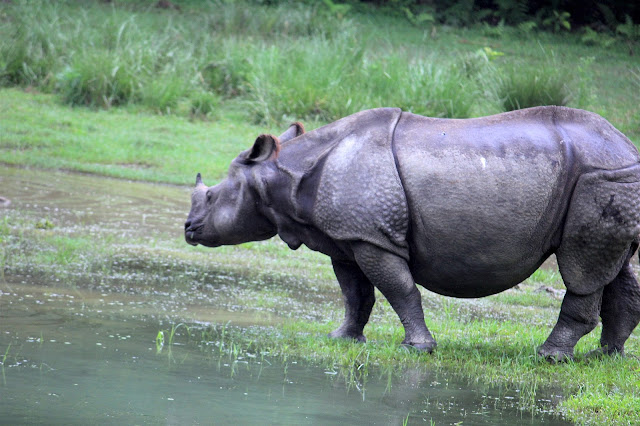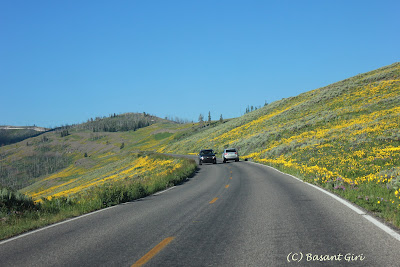It
has been three weeks since Nepal was hit by a killer earthquake. The massive
earthquake with a magnitude of 7.9 Richter scale occurred at 11:56 am (Friday
night MT) on 25th of April, 2015 killing nearly 8500 (as of May 18) people and
injuring more than twice as many. The epicenter of this quake was the Barpak
village of Gorkha district, 80 km northwest of capital city Kathmandu and
hypocenter was only 15 km deep. Hundreds of thousands of houses in Kathmandu and villages of
surrounding districts were earthen unimaginably. The quake even shook the
slopes of Mount Everest (the highest peak on earth) region triggering an
avalanche that buried part of a base camp packed with national and foreign
climbers preparing to make their summit attempts killing at least 18 people and
injuring about 61. It even shrunk Mount Everest by one inch and raised
Kathmandu by three feet as estimated by scientists using seismic interferometry.
The quake has also impacted northern India, Tibet and Bangladesh. About 8
million people are affected by the disaster in Nepal.
(update: Another big quake hit Nepal on May 12 that has killed ~150)
How did I hear?
My phone and social media profiles started flooding with
messages from families and friends asking my and my family’s safety, which I
saw only after I woke up at around 5 am the same day in Laramie. I got so
worried when I saw the pictures of the earthquake. Right after, I called my mom
living ~200 km west of the epicenter. I also talked to my sisters. They were
fine. My mom said that it was very hard shaking and for a long time. My dad was
not at home since morning that day and tensions rose as repeated phone calls
didn’t reach to him. He had gone to another town. Phone services were not
reliable because of sudden rise in the call traffic and damage in the
equipment. We were relieved when he came back home after few hours. I then
started contacting my relatives and friends. The only thing that mattered the
most at the beginning was to check my family was fine, be sad for those who
passed away in the earthquake and pray for the people. For three to four nights
everyone slept outdoors in an effort to stay safe from the aftershocks coming
one after another. Nature didn’t do justice when rain and thunderstorms
creating even more difficulty. More than 100 aftershocks of magnitude more than
4 made it the scariest. Getting right information from the ground using
personal contacts, calls, emails and social media posts was very crucial. It
was a very painful moment. Many of my friends were not able to know whether
their family members were still alive for days. Even though my family and
houses remain safe, houses of many of my friends got completely destroyed
beyond repair, some friends lost their parents and siblings. My friends who
also attended University of Wyoming and come from the village close to
epicenter lost their houses completely. One of my friends who has been planning
to complete his PhD in chemistry at the New Mexico State University in few
months lost his father and uncle in his house at Sindupalchwok district, one of
the hardest hit district, his mother was rescued live. My colleague lost her
sister, sister-in-law and their child. There is still a lot of trauma going on
for people. Many of them are still
outside, living in fields and tents. It is shocking and depressing to see how
people have lost their lives, their houses, schools and mental peace. It has,
at the same time, been difficult for the Nepali students at UW and their
families in Laramie as they try to cope with the situation and work towards the
end-of-semester.
Social media
The social media platform played very
crucial role to get us updated and make connections to the loved ones in this
difficult time. Communication
to loved ones back home was not easy, especially during the early hours. The
phone lines were so busy that it was hard to get through. Social media
such as Facebook and twitter along with Skype and viber became vital to check
on family and friends. Facebook’s “Safety Check” tool allowed anyone with a
Facebook account to check how many friends are in an affected area, and see how
many of them used the tool to confirm that they are safe. Google also launched
a Person Finder tool in Nepali and English, which allowed people to search for
and share information about missing persons. Web-based messaging tools like
WhatsApp helped people circumvent crowded or disrupted phone lines. Even though
I was far from home and not physically present there, I was able to closely
follow every update from Wyoming.
In memory of the century old heritage sites
The Himalayan quake has damaged not only houses but also
many monuments and temples listed in the UNESCO World Heritage Sites. Among
them was the 9 story tower at the center of Kathmandu known as Dharahara. This
tower was built in 1832. When I moved to Kathmandu in 1996 from countryside, it
was this white tower standing above all the buildings. One could clearly see
it. I had passed by this tower more than hundred times. We wished to climb this
tower one day to have a 360 degree view of Kathmandu valley and surrounding
mountains. In 2005, this tower was open to public. Then, I had climbed the
narrow stairs of the tower with my mom while she was visiting me in Kathmandu.
We went to the balcony at the 8th floor and watched Kathmandu for some time.
This tower was not just a tower but had become a monument, an icon of Kathmandu
and Nepal. Seeing it earthen brought tears into the eyes of millions. At first
when I saw the photograph of the grounded tower, I could not believe it. I
wished it was a bad dream. Unfortunately it was not. Also damaged were the
century old temples in Basantapur, Patan, and Bhaktapur Durbar Squares, all
listed in UNESCO heritage sites. I returned to Kathmandu after completing my
PhD from the University of Wyoming last year and was staying close to the Patan
Durbar Square area. Since then I have been to the heritage site several times
and have taken hundreds of photographs. Now they are in photographs only. I
know these places very well. The heritage and temples our ancestors built were
the attraction for millions of visitors from across the globe are now limited
to some photographs only.
Helpless
We knew that a big quake was coming but we were not sure
when. The science is not able to make earthquake prediction yet unlike warnings
for other natural disasters. There was very small effort to make houses quake
resistant in Nepal. Most of houses in rural Nepal are made from bricks and
stones joined by mud. These are the houses that were destroyed the most. Nepal
is known for tall mountains. The great Himalaya range lies in the intersection
of two giant tectonic plates of earth. Indian plate on south and Asian plate on
the north side of Nepal. The Indian plate moves towards Asian plate and because
of this movement, there is huge amount of energy stored inside the earth and
when it releases this energy that part of the world is shaken almost every 80
years.
In a time of hardship, everyone wants to be with the loved
ones to feel and share the pain. Unfortunately that was not possible for
millions of Nepali living abroad. Being far from home and your loved ones when
you could have helped had you been with them breaks our heart. Just seeing all
damage on news and social media and not being able to help by only pray makes
us feel helpless. Fortunately we Nepali are not alone at this moment. We are
surrounded by supportive communities and friends around the world. University
of Wyoming community and local Laramie community have been very supportive.
Everyone has expressed concern and solidarity. I participated in a candlelight
vigil prayer organized by Nepali community on Campus on Monday evening, 27th
April for those affected by the quake. There is very little we can do but with
the support from wonderful people around us, Nepali students attending the
University of Wyoming, Laramie have collected some fund and relief materials,
including medicines and school supplies to provide those to the victims when
few of us fly to Nepal after the end of semester.
Now the life is slowly coming to normal. While we have lost
peace of mind, we haven’t lost our hopes. We have to rebuild our heritage sites
and houses. We rebuilt after the 1934 big quake by ourselves when our country
was isolated and there was not much help from outside world. Good thing is this
time we are not alone. We are fortunate to have helping hands around the world
and we are well connected to them. Working together, we can for sure bounce
back stronger. At this tragic pain also, smiles on Nepali faces has not been
buried. People are helping each other, sharing food and shelter, which is a
part of our culture. It has brought every Nepali together. Now, it’s time to
build new Nepal. I will be going back to Nepal in two weeks and will see the
devastation personally.
























































